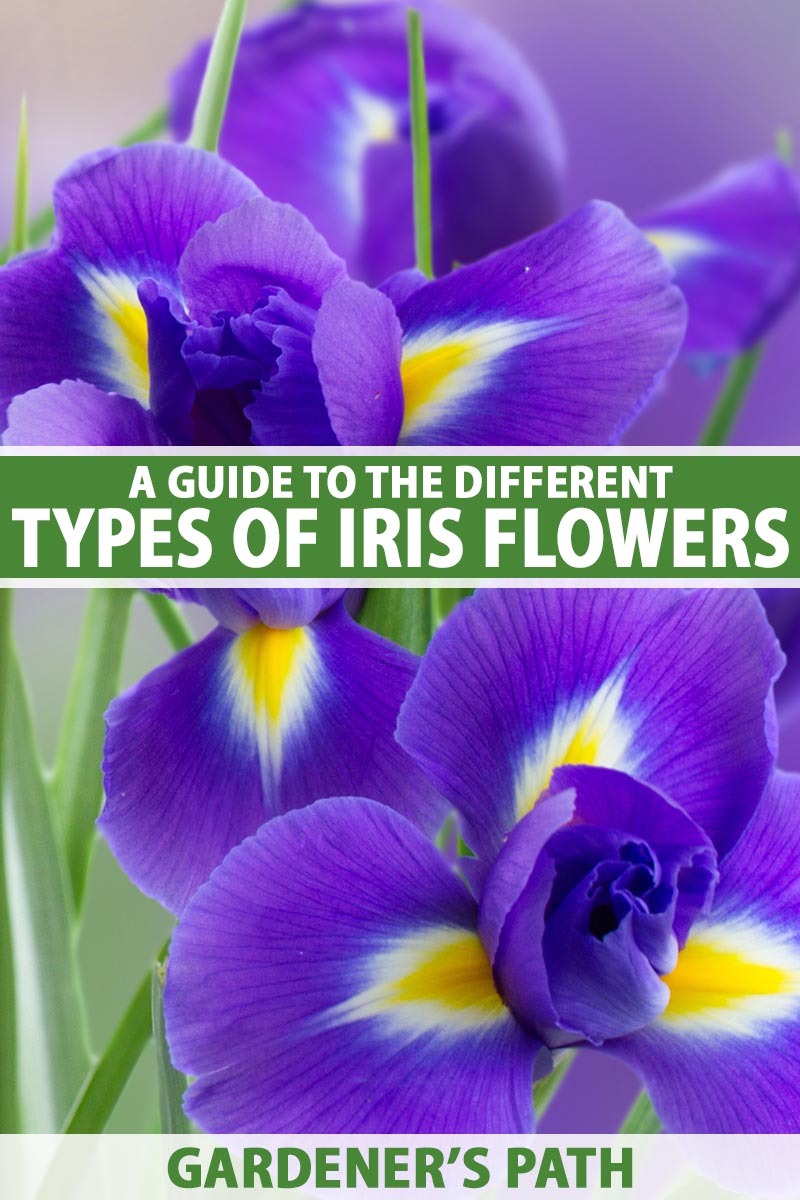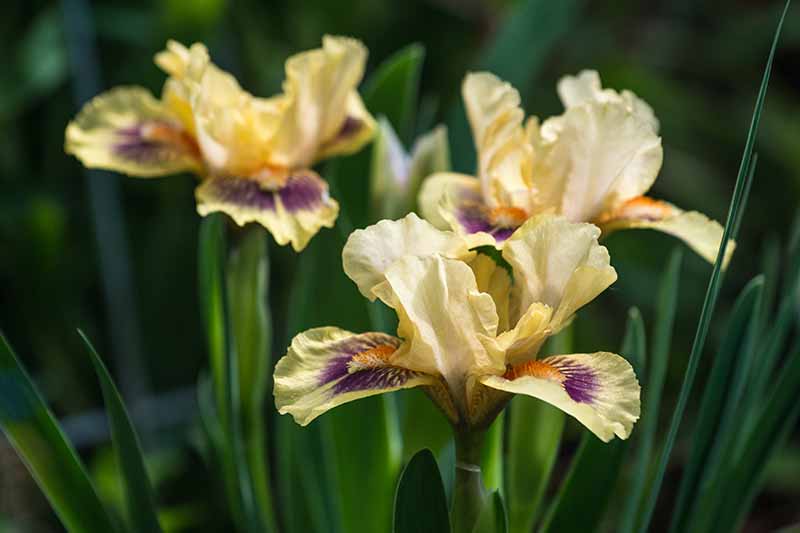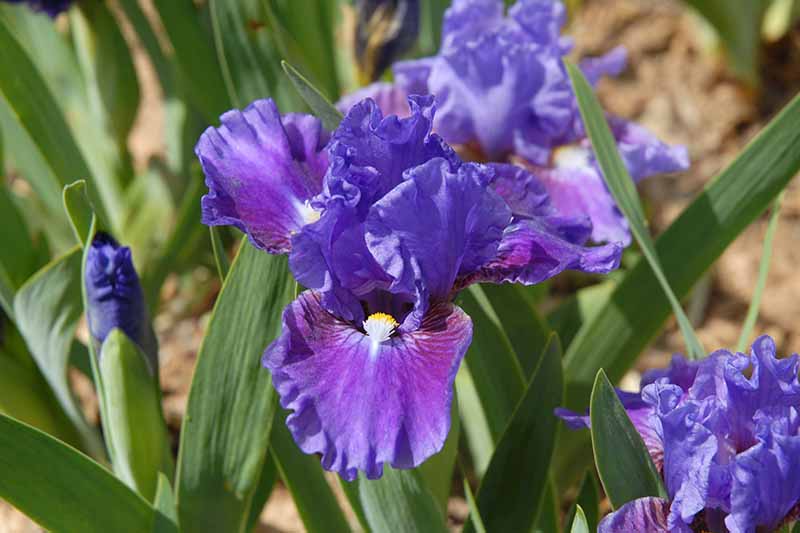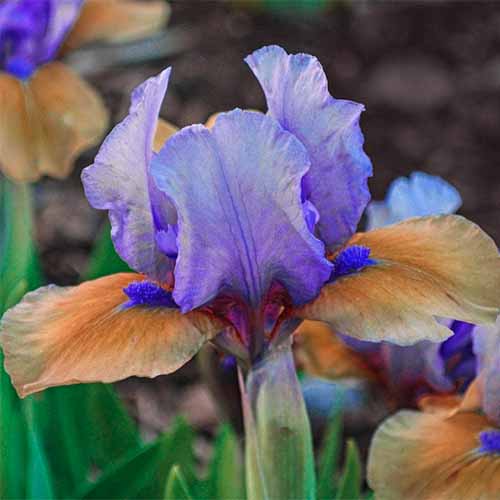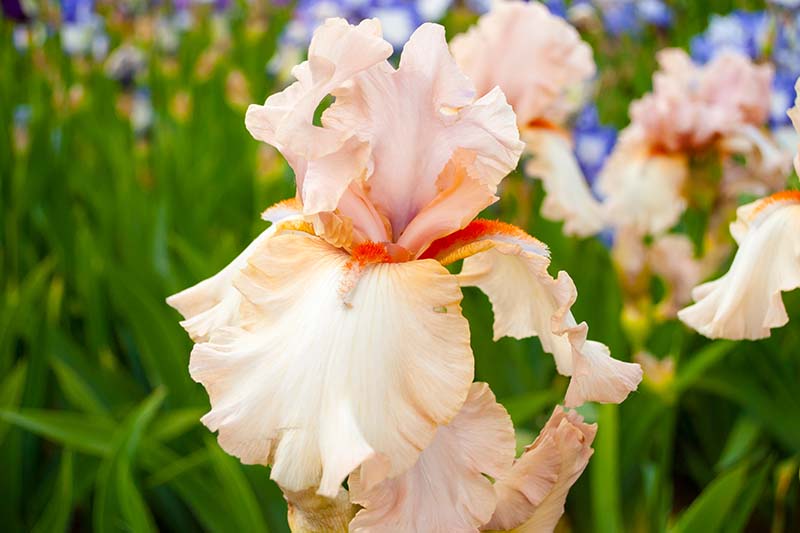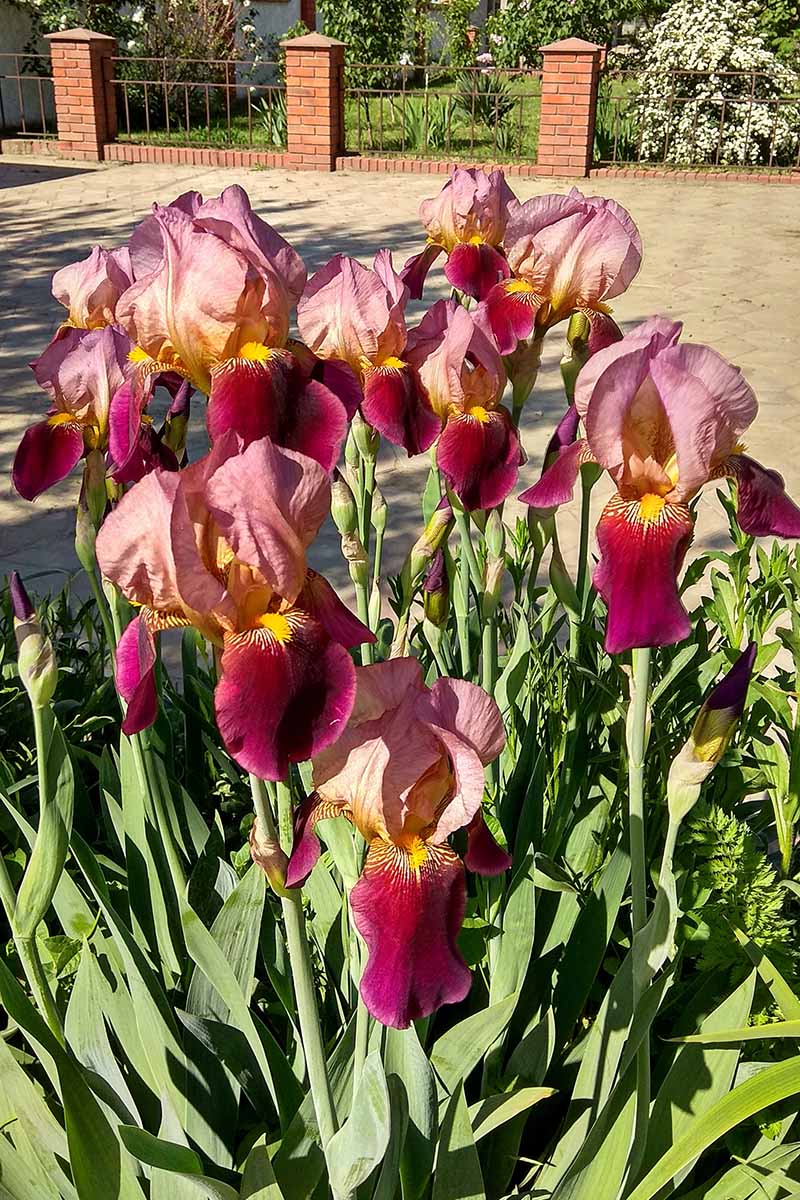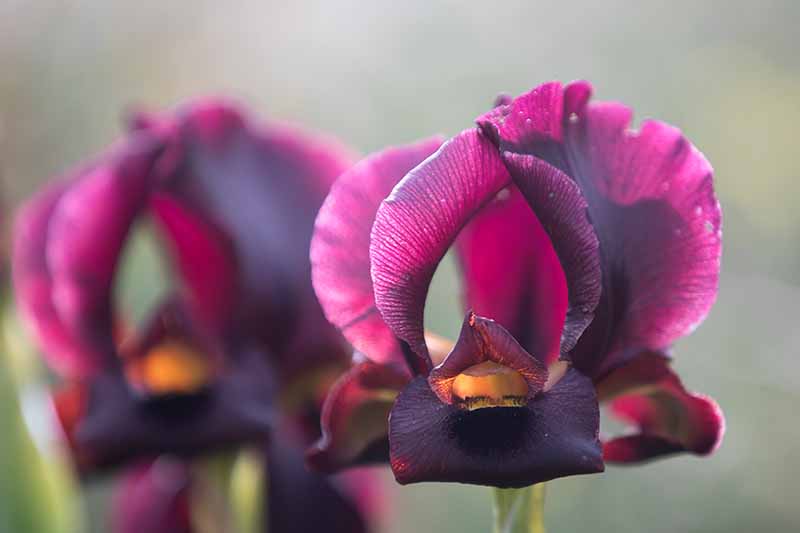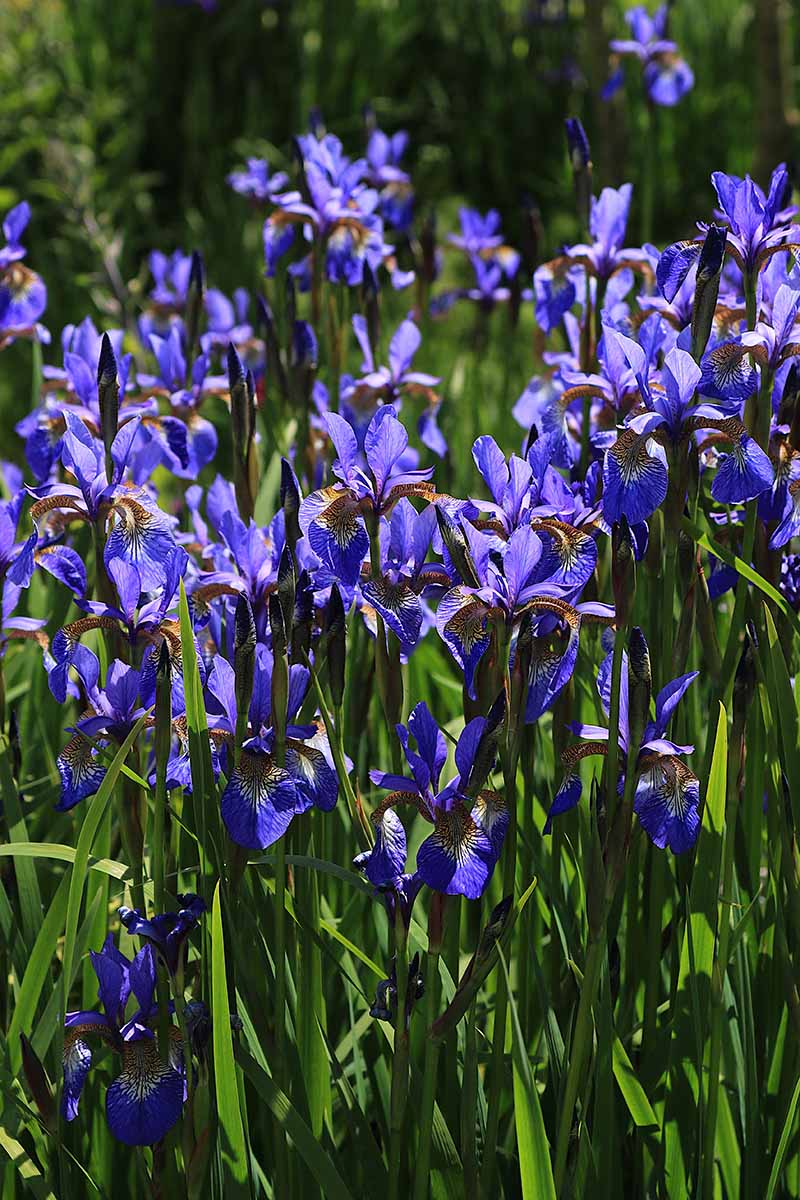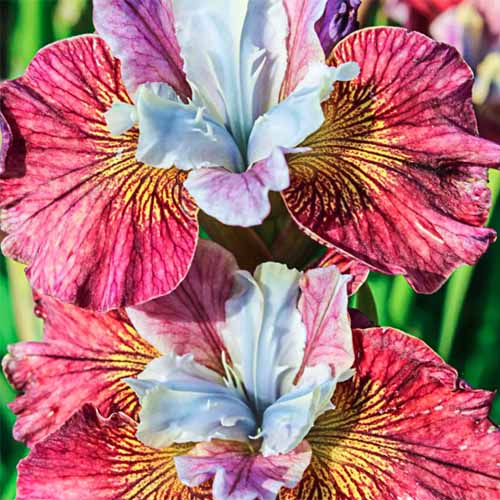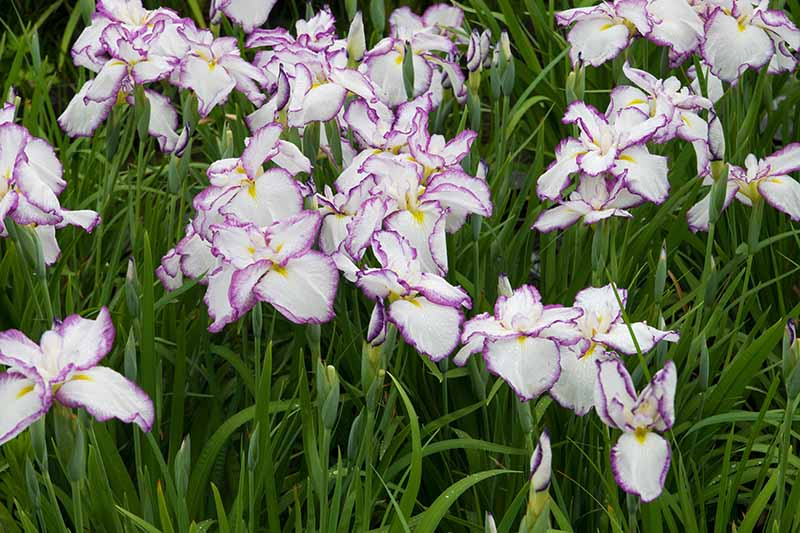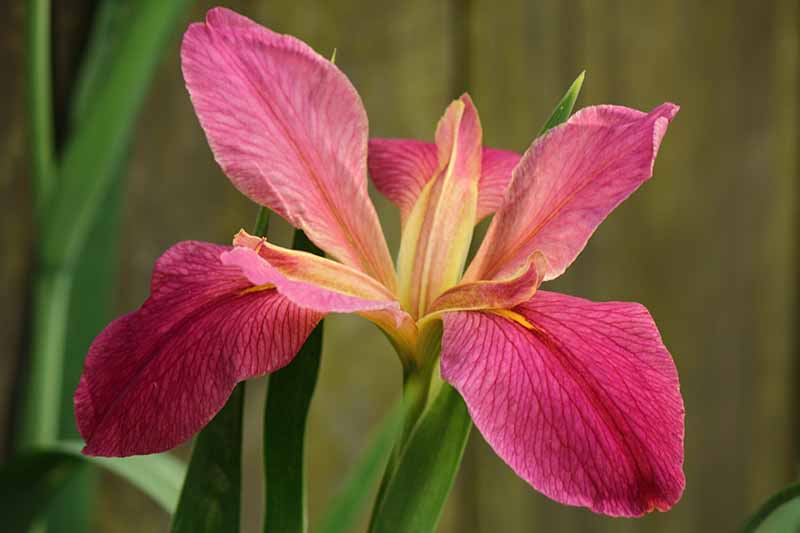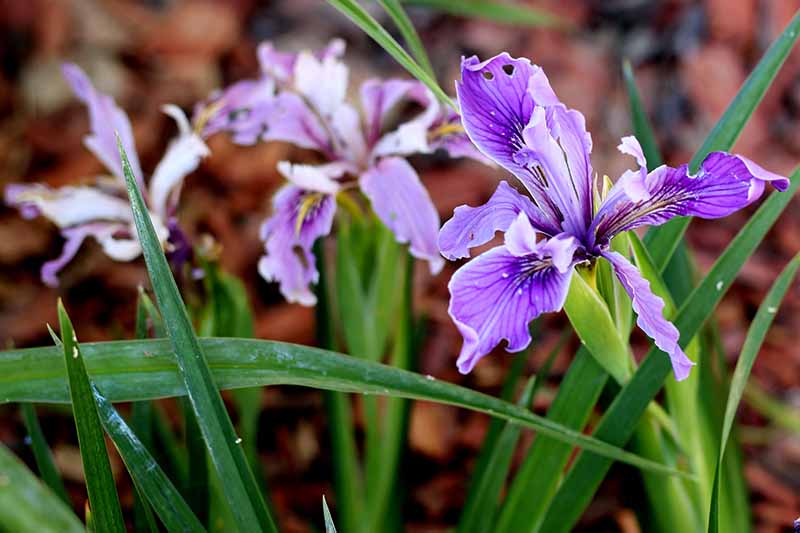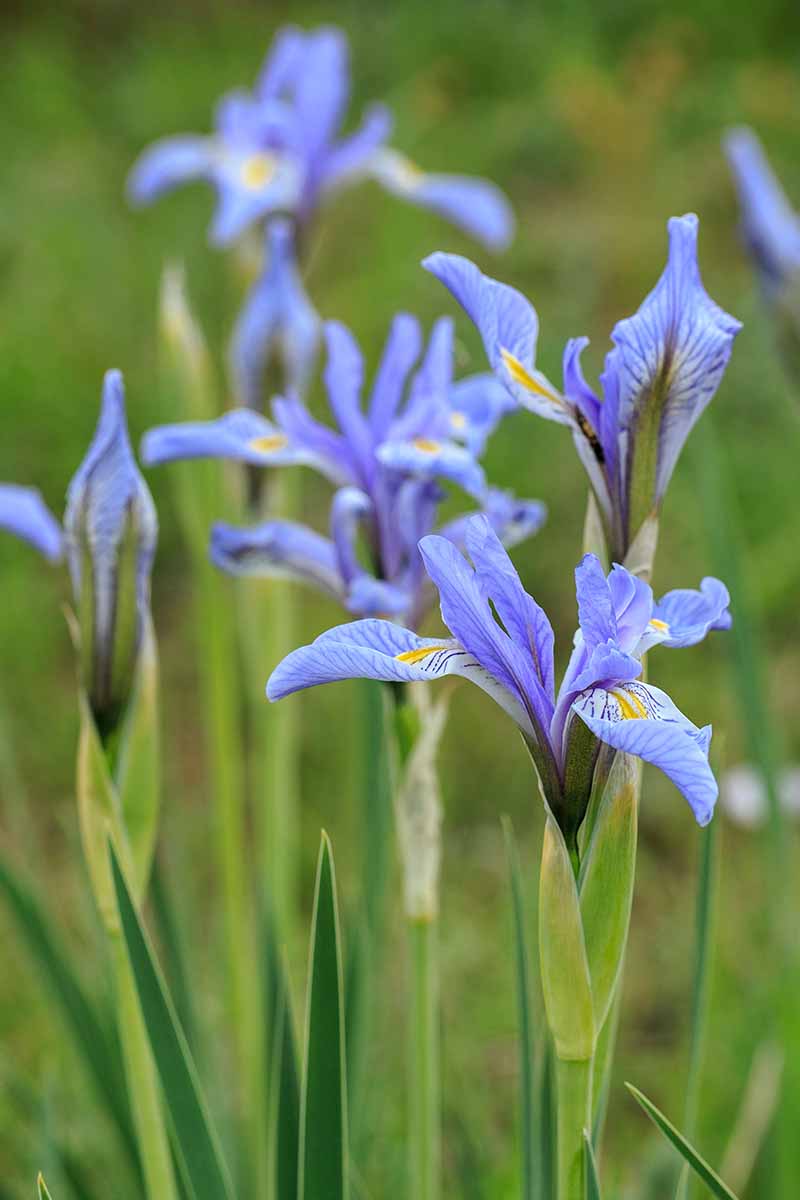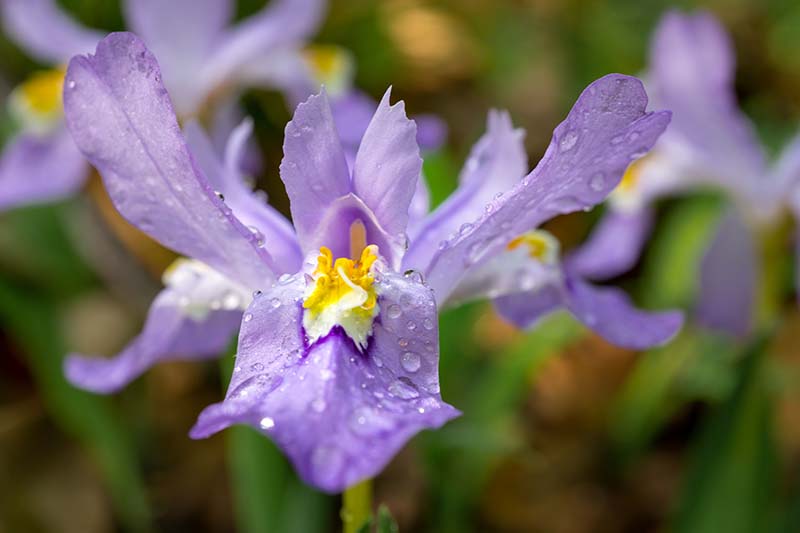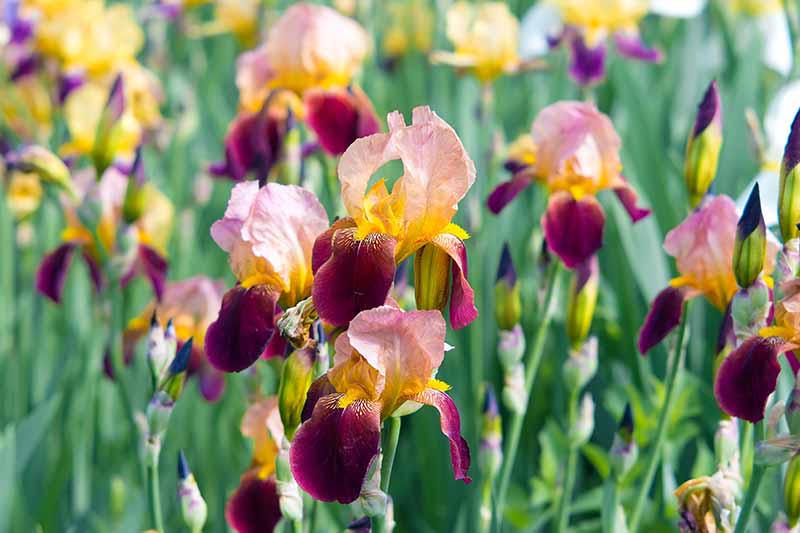They add charm and grace to beds, borders, and containers, plus numerous landscape settings from cutting gardens to creek banks. This large genus in the Iridaceae family has numerous subgenera, species, sections, and cultivars that give us a fantastic array of plants to choose from. We link to vendors to help you find relevant products. If you buy from one of our links, we may earn a commission. With careful selection, you can enjoy their sumptuous rainbow colors and sweet, floral fragrance over a long season, from early spring through to midsummer. In our guide to growing irises, we cover how to cultivate these showy flowers in your landscape. To ensure you make the best choice for your garden space, dig in now to learn about the different types of irises and their flowering sequence.
Classifications
According to the American Iris Society (AIS), plants fall into three main groups: Bearded, Aril, and Beardless. Let’s look at each group in turn.
Bearded
The highly popular Bearded category all derive from I. germanica, a species native to southern Europe and the Mediterranean. The showy, full-petaled flowers have a sweet, floral fragrance and are marked by a beard at the base of the lower petals (falls). The beard is a small mat of soft, short hairs that may be the same color as the petals or contrasting – a little soul patch for attracting pollinators! These plants have thick, fleshy rhizomes that grow with the tops of these exposed to the sun and air. They require humus-rich, well-draining soil in a full sun location and are typically hardy in Zones 3-9. The Bearded category has six groups based on shared characteristics such as size and flowering time. The shortest plants flower first, followed by intermediates, and the tallest are the last to bloom. Some reblooming cultivars flower first in spring with a second flush from late summer into early fall.
Miniature Dwarf Bearded
Miniature Dwarf Bearded (MDB) types are adorable early spring bloomers that flower in late March to early May and measure up to eight inches tall. They look spectacular massed in beds, containers, naturalized drifts, and rockeries.
Standard Dwarf Bearded
Flowering immediately after the MDBs, typically in April and May, Standard Dwarf Bearded (SDB) varieties top out at eight to 16 inches tall. They are superb for spring borders or to create large cushions of color in beds, containers, and drifts.
Intermediate Bearded
Intermediate Bearded IB) types are beautifully branched plants that grow 16 to 27 inches tall and overlap the flower times of the Standard Dwarf Bearded and Tall Bearded groups, blooming throughout May and June. ‘Blueberry Tart’ It grows 10 to 14 inches and is a standout massed in beds, borders, containers, and foundations or in cottage, courtyard, and cutting gardens. Hardy in Zones 4-9. Bare root plants are available at Home Depot. They are striking when mass planted in island beds or as specimens in mixed perennial borders.
Border Bearded
The Border Bearded (BB) group are similar in size to Intermediate Beardeds, growing 16 to 27 inches tall, and they flower in May and June. Border Beardeds are gorgeous for beds, borders, foundations, and as cut flowers. They also make a good choice in areas prone to high winds thanks to their sturdy stems.
Miniature Tall Bearded
Miniature Tall Bearded (MTB) types reach 16 to 25 inches tall and flower in May and June. With elegant, branched stalks, flowers in this group are prized for floral arrangements and form beautiful clouds of color in beds, borders, and foundation plantings.
Tall Bearded
Tall and stately, with robust, branched stems and multiple buds, Tall Bearded (TB) irises grow 28 to 48 inches tall and flower in May and June. They are fantastic for cut flowers or massed in island beds, borders, foundations, and drifts.
Aril
The Aril group is comprised of species in the Oncocyclus and Regelia sections of the Iris genus that are native to semi-arid and desert regions of the near East. These are tall and flamboyant plants that may or may not have beards but are best known for their extravagant range of rich colors – often with large, dark “eyes” and dramatic streaks, swirls, or veining. Highly fussy about their location, Arils demand excellent drainage, full sun, and thrive in hot locations. Aril species are difficult to grow in all but the driest and hottest regions. However, cross breeding with Bearded varieties has produced many attractive hybrid cultivars. Known as “arilbreds” they are suitable for growing in most regions and typically flower in May and June. Not as widely used in home gardens as the other two groups, arilbreds can be found at online bulb houses and plant specialty sites. Popular arilbreds include cultivars like ‘Kalifa’s Joy’ and ‘Refiner’s Fire.’ To improve drainage and heat retention, raised beds are often used for growing Arils and arilbreds. They are typically hardy to Zone 7.
Beardless
Beardless varieties comprise a number of different species native to Asia, Europe, and North America. These types typically enjoy areas with a high water table, such as beside bogs, creeks, and marshes. The rhizome is smaller than that of Bearded varieties, and looks more like a large corm with long, fibrous roots below. This adaptation means Beardless rhizomes can be buried under a thick mulch to retain moisture without the concern of rot – a problem for Bearded varieties. Also, they’re not as susceptible to root borers either. Members of this group are typically hardy in Zones 4-9.
Spurias
Also known as blue iris, Spurias (SPU) belong to the species I. spuria, and are native to Africa, Asia, and Europe. Among the tallest of the Beardless group, they easily reach three to five feet in height. The elegant flowers have slim standards and falls that give an airy, dragonfly profile and make stunning cut flowers. Plants form large, attractive clumps that rarely need dividing and flower in May and June, overlapping Tall Bearded and Japanese groups. They require consistent, moist soil conditions from October to flowering.
Siberian
Sophisticated and reliable, Siberians (SIB), I. sibirica and I. sanguinia, are midsized plants of two to four feet in height, native to central Europe and Asia. They feature stylish, fluted petals that flower throughout May and June, overlapping with the earlier Tall Bearded and later Japanese varieties. For the first year after planting, keep the soil evenly moist. Although drought tolerant, Siberians perform much better in conditions that are wet in winter and moist through spring until flowering is finished.
Painted Woman
A flamboyant Siberian, I. sibirica ‘Painted Woman’ has lightly fragrant and uniquely colorful flowers that bloom in late spring to early summer.
Japanese
Japanese (JI) types are native to Japan, China, Korea, and Russia. They provide a tall, refined presence with captivating orchid-like blooms on abundantly branching stems. ‘Painted Woman’ Plants grow up to 28 inches and require moist soil to flourish. Splendid when massed by pools, rills, or water features. Hardy in Zones 3-9. Bare root plants are available at Home Depot. I. ensata plants grow four to five feet tall and are among the latest to flower, blooming from late June to August. They make an excellent choice beside ponds or streams and require plenty of moisture, with wet soil conditions from October to bloom time. Plant rhizomes two to three inches deep in a water-collecting depression, then fill the depression with mulch to retain moisture – never allow the roots to dry out.
Lion King
You’ll roar with delight when you see the impressive, fully double blooms of this tall, summer flowering Japanese cultivar.
Louisiana
The Louisiana group (LA), I. ser. Hexagonae, is comprised of five species – I. brevicaulis, I. fulva, I. giganticaerulea, I. hexagona, and I. nelsonii – native to Arkansas, Florida, Louisiana, and Mississippi. ‘Lion King’ Reaching a stately 36 to 48 inches, these showy plants require moist, well-draining soil and look spectacular massed around rills, ponds, and water gardens. Container plants are available at Nature Hills Nursery. These attractive species grow two to three feet tall and hybridize freely within the group, producing flower colors not found elsewhere. Flowering in April and May, this is another moisture-loving group that thrives in aquatic or rain gardens, beside ponds and streams, or low-lying, moisture-retentive areas.
Pacific Coast Native
Native Iris species grow all along the west coast of North America, from southern California right up to Alaska and the Arctic.
Black Gamecock
An excellent example of the Louisiana group, I. hexagona ‘Black Gamecock’ flowers in late spring to early summer and features velvety flowers of deep royal purple with a slim yellow signal. ‘Black Gamecock’ Plant grow up to 60 inches and make magnificent cut flowers. Also an excellent choice for massing around ponds, pools, or water gardens – moist soil is a must. Hardy in Zones 4-9. Container plants are available at Nature Hills Nursery. However, the Pacific Coast Native (PCN) group, formerly Californicae (CA), is comprised of 12 to 14 species that occur predominantly in northern California, Oregon, and southern Washington. PCNs include species such as the Douglas (I. douglasiana), Purdy’s (I. purdyi,), and tough-leaf (I. tenax) irises. They’re hardy in Zones 5 to 9 and flower in March to May, but are rarely cultivated outside of their Pacific coast habitat. Stock can be difficult to source as well. Look to Alpine flower societies or native plant houses for bare roots or seed. A branch of the AIS, the Society for Pacific Coast Native Iris, has a seed exchange that takes place every fall, around October and November.
Species
Species plants, such as I. confusa, I. missouriensis, I. tectorum, and I. versicolor, often grace our gardens and typically prefer an environment similar to that of their native habitats. Species plants usually flower in May and June and can be found in your local garden center or online at native flower or specialty plant sites. The crest is a raised ridge or cockscomb and a signal is a flash of contrasting color. Water Iris Plants grow 30 to 36 inches tall and makes a regal statement when massed in moist soil by ponds, streams, and water gardens. Hardy in Zones 3-9. Container plants are available at Nature Hills Nursery. Crested irises, I. cristata are included in the Species group and typically have a crest or signal on the falls in place of a beard.
Bulbous Varieties
Along with the many rhizomatous varieties listed above, bulbous varieties, such the early flowering reticulatas (I. reticulata), Dutch (I.hollandica), English (I. latifolia), Spanish (I. xiphium), and I. danfordiae species and cultivars, make a welcome garden addition as well. These are easy and rewarding in the garden as well, and nicely extend the flowering season. For cultivation details, check out our guide on how to grow bulbous iris.
Flowering Sequence
In addition to the classifications above, plants are loosely grouped into three flowering times of early, mid, and late season. ‘Harmony’ Plants grow six to eight inches tall and make a beautiful addition to borders, containers, rockeries, and naturalized areas or when planted with other early flowers like crocus and snowdrops. They are also a good choice for indoor winter forcing. Hardy in Zones 3-9, these fall-planted bulbs are available at Burpee.
Red Ember
For smoldering flowers in May and June, I. hollandica ‘Red Ember’ is a bulbous Dutch cultivar with deep purple standards and russet falls emblazoned with a gold signal and dark veining. ‘Red Ember’ Plants reach up to 20 inches tall and look terrific clumped in beds, borders, containers, foundations, and throughout the garden – Dutch cultivars are also prized as long-lasting cut flowers. Hardy in Zones 6-9. Fall planted bulbs are available at Burpee.
Dwarf bulbous varieties such as I. reticulata and I. danfordiae are the earliest, flowering in late winter and early spring (late February to April).Dwarf and Miniature Bearded cultivars bloom in early to mid-spring (late March to May).Arils, arilbreds, Intermediate Bearded, and Louisianas bloom in late spring (April and May).Border, Miniature Tall, and Tall Bearded cultivars flower from mid-spring into early summer (mid-May to mid-July).Siberians and Spurias bloom in late spring to early summer (May to July).Bulbous European varieties flower in late spring to midsummer and include Dutch, English, and Spanish species and their cultivars (late May to July).Japanese varieties bloom from early to midsummer (June and July).Reblooming bearded cultivars flower first in mid-spring then again from late summer to early fall.
With careful selection and the right conditions, you can enjoy several months of these beautiful flowers! Remember that the Bearded and Aril groups need a well-draining site with the rhizome tops exposed to the sun. And the Beardless group require moist soil until they finish blooming. Meet these conditions, and you can enjoy months of their scented elegance! Are you growing irises in your garden? Let us know about your favorites in the comments section below! And for more information on caring for iris flowers, check out these guides next:
How to Plant and Grow Iris Flowers33 of the Best Iris Cultivars for Your Garden5 Easy Steps to Store Iris Rhizomes In Winter
